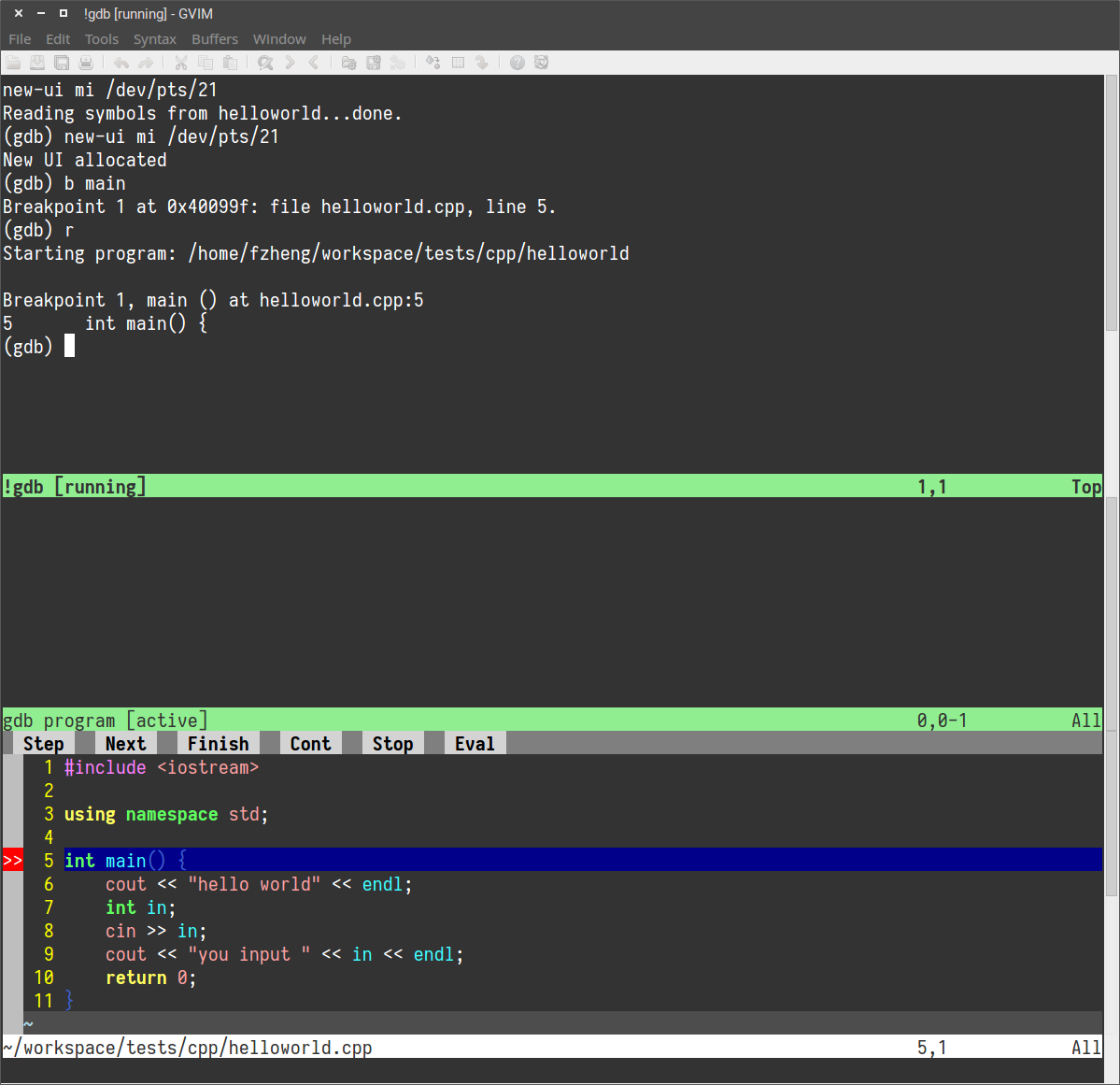简介
termdebug 是从 Vim 8.1 开始内置的调试插件,仅支持 GDB。
本教程仅在 Linux 下(Ubuntu 16.04)测试通过。
安装
将 Vim 升级至 8.1 或以上版本。
GDB 需升级至 7.12 或以上版本。
启动
默认情况下需手动加载 termdebug 插件:
:packadd termdebug
假设我们有一个简单的 helloworld.cpp 文件:
#include
using namespace std;
int main() {
cout << "hello world" << endl;
int in;
cin >> in;
cout << "you input " << in << endl;
return 0;
}
我们将其编译为二进制文件 helloworld:
g++ -g helloworld.cpp -o helloworld
现在,我们在 Vim 中启动 termdebug 来调试这个程序:
:Termdebug helloworld
这时 termdebug 会为我们开三个窗口。
其中, GDB 窗口提供 GDB 原生操作;程序窗口供被调试程序使用,提供 IO 功能;源码窗口提供源码交互。
在 GUI 版本的 Vim (如 gvim)中,源码窗口还提供交互按钮:

我们可以通过 按键切换不同窗口。
调试程序
我们既可以在 GDB 窗口中调试,也可以在源码窗口中调试。
GDB 调试常用指令:
- file bin 加载名为 bin 的二进制文件
- CTRL-C 中断程序
- run/r 运行
- next/n 执行当前行,停在下一行 (step over)
- step/s 执行当前行,进入下一层函数 (step in)
- finish 执行直至离开当前函数
- where 显示栈
- continue/c 继续执行
- break/b N 在第 N 行加断点
- break/b f 在函数 f 处加断点
- delete 删除所有断点
更多 GDB 使用方法请参考官方文档: https://sourceware.org/gdb/current/onlinedocs/gdb/
在源码窗口中的调试指令:
:Run [args] 运行程序,可带参数 [args],或沿用上一次运行的参数
:Arguments {args} 设置下一次运行所用参数
:Break 在当前行加断点
:Clear 删除当前行的一个断点
:Step = gdb "step"
:Over = gdb "next"
:Finish = gdb "finish"
:Continue = gdb "continue"
:Stop 中断程序
如果觉得手动输入调试指令太麻烦,可以在个人的 .vimrc 文件中自定义 keymap 来执行这些命令,如用 来添加断点:
nnoremap :Break
现在我们来演示一下调试上面的已经加载好的 helloworld 程序:
先移动至 GDB 窗口,输入 b main 以在 main 函数入口处添加断点;
在 GDB 窗口输入 r,程序开始运行,并停在 main 函数入口;
在 GDB 窗口输入 n,程序停在 cout << "hello world" << endl; 这一行;
移动至源码窗口,输入 :Continue,程序继续运行,并在 cin >> in 处等待用户输入;
移动至程序窗口(IO窗口),输入数字 3 并回车,可以看到程序输出 you input 3,并运行直至结束;
移动至 GDB 窗口,输入 q,退出调试。
获取帮助文档
在 Vim 窗口中输入 :h terminal-debug 阅读详细的帮助文档。






)




【东华理工大学吧】_百度贴吧...)


)




![BZOJ 4819: [Sdoi2017]新生舞会](http://pic.xiahunao.cn/BZOJ 4819: [Sdoi2017]新生舞会)